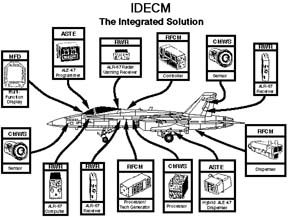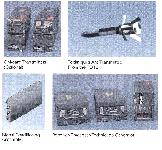





The IDECM suite is intended to provide self-protection and increased survivability for tactical aircraft against radio frequency (RF) and infrared (IR) surface-to-air and air-to-air threats. The major hardware component to be developed by the IDECM program is the IDECM RFCM (radio frequency countermeasure) system. The additional major functional component to be developed under the IDECM program is IDECM Integration.
IDECM will integrate specific electronic self protection systems on the host aircraft. For the IDECM lead aircraft, the F/A-18E/F, these systems are defined as the radar warning receiver, the Common Missile Warning System (CMWS, after completion of its own OPEVAL in the USMC AV-8B and the USAF F-16 Block 40 CAS), the AN/ALE-47 chaff/flare dispenser, the AN/ALE-50 (off-board decoy) launch controller/dispenser and the RFCM. Upon completion of its own OPEVAL, the Advanced Strategic Tactical Expendable is one of several expendables which may be dispensed by the AN/ALE-47. Integration of these systems is intended to provide threat system warning, threat missile detection/warning, and the most effective countermeasure response, to increase survivability of the host aircraft against IR and RF threats.
The RFCM consists of an onboard receiver/processor/techniques generator which stimulates a fiber optics towed decoy (FOTD) for transmission of the countermeasure technique. The FOTD is intended to be compatible with and deployed from the AN/ALE-50 (off-board repeater) launch controller/dispenser. An optional onboard transmitter is a possible addition to the configuration.
IDECM RFCM is intended to fill the electronic self protection operational deficiency for Navy tactical aircraft. USAF requirements for a common FOTD and techniques generator and a high power FOTD, were included in the IDECM EMD contract. USAF initial interest is in IDECM RFCM applications as components of the defensive system architecture for the F-15 and B-1B.
The FOTD provides aircraft protection against modern radar-guided missiles to supplement traditional radar jamming equipment. The device is towed at varying distances behind the aircraft while transmitting a signal like that of a threat radar. The missile will detect and lock onto the decoy rather than on the aircraft. This is achieved by making the decoy�s radiated signal stronger than that of the aircraft. The system will greatly enhance existing onboard defense against radar guided missiles, thus improving the survivability of both aircraft and flight crew against radar guided threats.The IDECM acquisition/operational test and evaluation strategy for the F/A-18E/F includes an OA of the RFCM to support a RFCM LRIP in 2QFY99. The OA will be based on flight testing in an avionics test bed aircraft which is an F/A-18E/F surrogate implemented in an F/A-18C/D airframe. Due to airframe limitations, the AN/ALE-50 launch controller/dispenser with the FOTD will be pod carried and interfaced with the internal avionics.
On a parallel schedule, the F/A-18E/F platform OPEVAL is scheduled from 3QFY99 through 1QFY00. The OPEVAL aircraft will not yet be equipped with the IDECM RFCM, but will carry the AN/ALE-50 and off-board decoy.
F/A-18E/F FOT&E with IDECM RFCM is planned concurrently with the RFCM OT phase IIA (OT-IIA) which is to be the OPEVAL for the RFCM supporting RFCM Milestone-III and B-LRIP in 1QFY01. OT-IIB is planned as the OPEVAL for IDECM Integration (subsequent to the CMWS Milestone-III and integration in the F/A-18E/F) supporting the IDECM Integration Milestone-III in 3QFY02.
Milestone-II was achieved 1QFY96 without a DOT&E approved TEMP. Since 4QFY95, the Navy test and requirements communities, and the IDECM program management, have worked closely with DOT&E staff towards closure on DOT&E TEMP issues. This effort yielded a January 1996 agreement among TEMP integrated product team (IPT) principles on resolution of DOT&E issues. A March 1996 COMOPTEVFOR IDECM Test Concept paper was formally endorsed by DOT&E as answering critical DOT&E TEMP issues. COMOPTEVFOR "scrubbed" the affected portions of the current "Navy approved" TEMP to incorporate the test concept and resource requirements agreements and provided proposed TEMP changes to the IDECM PM in June 1996. The IDECM program manager chose to delay re-submission of the TEMP to OSD until the April 1997 time frame. A new TEMP IPT was constituted in September 1996 with their focus on incorporating the previous agreements in conjunction with changes required to reflect the December 1996 completion of the IDECM critical design review.
Early involvement by the OT community, including aggressive COMOPTEVFOR leadership in the IDECM program, is driving several initiatives to upgrade range/test facilities and instrumentation in support of an integrated DT/OT and modeling and simulation strategy. Multi-spectral systems and towed decoys present a number of challenging operational test and evaluation limitations, some of which may only be resolvable through the iterative integration of physics-based modeling and simulation with DT/OT events. Establishing and evaluating meaningful operational measures of effectiveness is a significant OT&E challenge for this program. Although the TEMP is not yet approved by DOT&E, the program and early T&E activity are progressing on the schedule outlined in the Navy TEMP.
PROGRAM STATUS/SCHEDULE:
| MSII | DT&E | OT&E | MSIII | Deliveries | |
| IDECM | Oct 95 | 2Q99 | 3Q01 | 2Q02 | 1Q04 |
| IDECM RFCM | 3Q98 | 3Q99 | 2Q01 | 1Q02 | |
| B-1B DSUP | Oct 96 | 2Q98 | 3Q01 | 2Q02 | 2Q02 |
| F-15 | 2Q00 | 4Q01 | 2Q02 |
| Measure | FROM | TO |
| Program Office Manning | 22 | 13 |
| Military Standards and Specifications Used | 40 | 3 |
| Projected Average Unit Price | $35K | $20K |
| Number of Platforms (Applicability) | 2 | 4 |
| Projected Program Cost Avoidance | $275M | |


